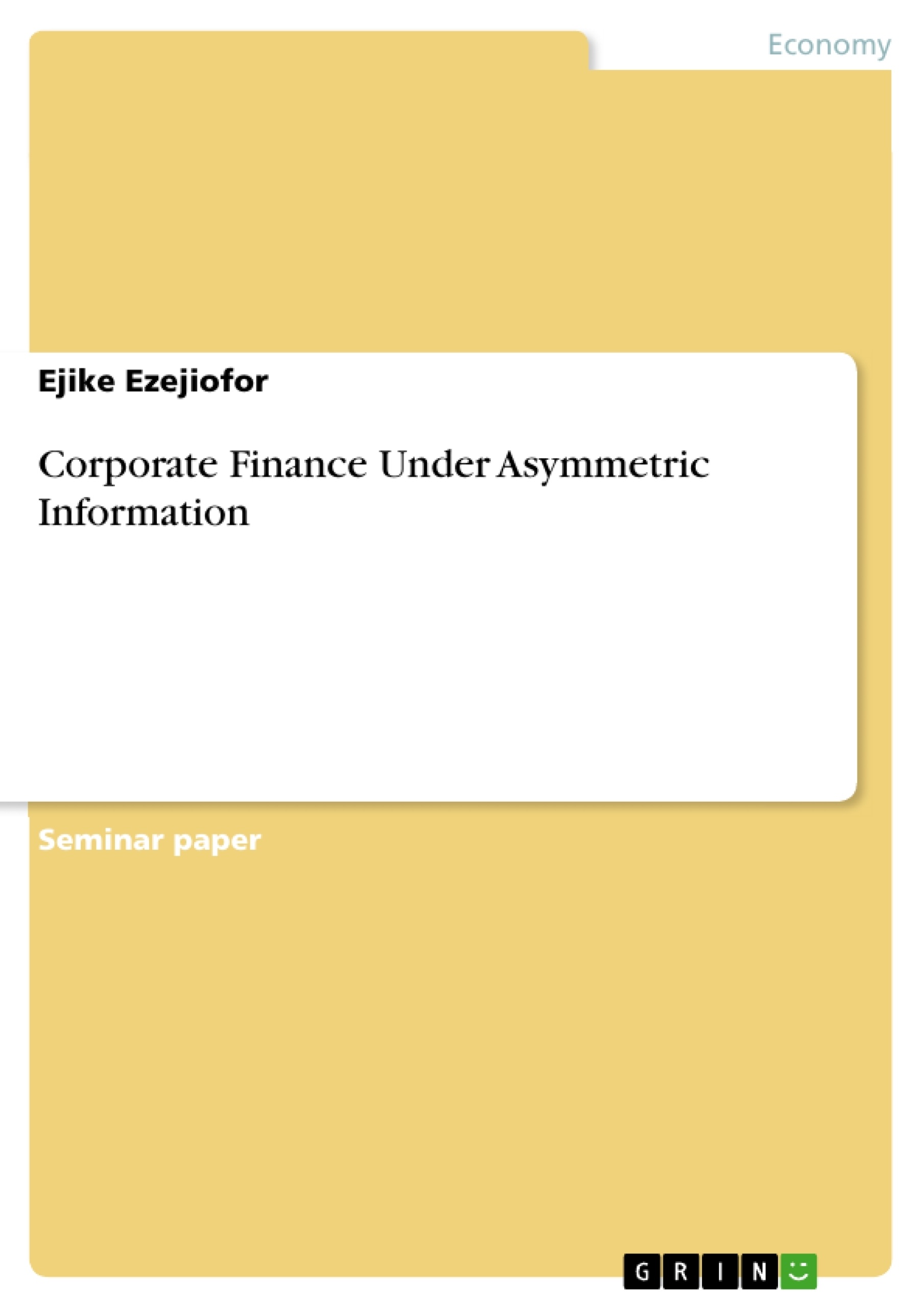The specter of decreased economic activities, financial crisis, unbecoming ethical standards have in the recent past and fore going, characterized asymmetric information on corporate finance. The consequences normally have a ricochet effect and can be generally catastrophic to normal economic activities to mention the least. This paper considers scenario’s where information asymmetry was prevalent or may have had its effects play out. The typical investor mindset and the opportunity cost associated with the preferred capital structure of the capitalizing process were mentioned.
A basis for proper appreciation of the concept – Corporate finance under asymmetric information was initiated here, with a detailed explanation of corporate finance and its components, this was succeeded by a summary of scenarios were asymmetric information were prevalent and an intelligent look was also taken at asymmetric information between insiders and investors and the concomitant lemon problem, where the effects were carefully highlighted in a progression to the level of severity - Market breakdown and costly signaling.
The fact that asymmetric information has been widely recognized as bad and generally viewed in a negative light must warrant it being viewed with a high level of seriousness. It is widely known that while lot of effort have been put into stemming the tides of the consequences of asymmetric information, a lot of effort too, have been dedicated to innovation and risk assessment, to capture the interest of investors, who have been affected by the consequences of asymmetric information. These may have formed a veritable platform for a recent paper by Pierre Barbaroux (2014), that elucidated the rise of innovation and innovative entrepreneurs based on the management of asymmetric information. An attempt has in any case, been made here to suggest efforts at marginalizing the negative impacts of asymmetric information and also remedies at reducing the far reaching impacts on the lenders and the aggregate economic activity in general.
Inhaltsverzeichnis
- ABSTRACT
- CORPORATE FINANCE
- CORPORATE FINANCE UNDER ASYMMETRIC INFORMATION
- CONSEQUENCES OF FINANCIAL DECISIONS WERE ASYMMETRIC INFORMATION EXISTS ARE LISTED AS THUS
- ASYMMETRIC INFORMATION BETWEEN INSIDERS AND INVESTORS AND THE CONCOMITANT LEMON PROBLEM
- MARKET BREAKDOWN AND COSTLY SIGNALING
- SUMMARY
- REFERENCES
Zielsetzung und Themenschwerpunkte
This paper explores the implications of asymmetric information in corporate finance, analyzing its impact on financial decisions, market dynamics, and the overall economic landscape. The paper examines the consequences of information asymmetry, including the "lemon problem" and costly signaling, and explores potential solutions to mitigate these challenges.
- The impact of asymmetric information on corporate finance decisions.
- The "lemon problem" and its implications for market efficiency.
- Costly signaling as a strategy to overcome information asymmetry.
- The role of innovation and entrepreneurship in mitigating information asymmetry.
- The importance of risk assessment and financial planning in a context of asymmetric information.
Zusammenfassung der Kapitel
The paper begins by defining corporate finance and its key components, including equity, debt, and value. It then delves into the concept of asymmetric information, highlighting its prevalence in financial markets and its potential to create market failures. The paper explores the consequences of asymmetric information, including the "lemon problem," where investors are unable to distinguish between good and bad investments due to a lack of information. This leads to a breakdown in market efficiency and can discourage investment. The paper also examines costly signaling, a strategy employed by firms to convey information to investors and mitigate the effects of asymmetric information. This can involve actions such as issuing dividends, providing financial statements, or engaging in other activities that signal the firm's quality and future prospects. The paper concludes by discussing the role of innovation and entrepreneurship in addressing information asymmetry. By developing new technologies and business models, entrepreneurs can create opportunities to overcome information barriers and improve market efficiency.
Schlüsselwörter
The key terms and focus themes of the text include asymmetric information, corporate finance, financial decisions, market efficiency, the lemon problem, costly signaling, innovation, entrepreneurship, risk assessment, and financial planning. The paper explores the challenges and opportunities presented by asymmetric information in the context of corporate finance, highlighting its impact on investment decisions, market dynamics, and the overall economic landscape.
- Arbeit zitieren
- Ejike Ezejiofor (Autor:in), 2014, Corporate Finance Under Asymmetric Information, München, GRIN Verlag, https://www.grin.com/document/283840
-

-

-

-
Laden Sie Ihre eigenen Arbeiten hoch! Geld verdienen und iPhone X gewinnen. -

-
Laden Sie Ihre eigenen Arbeiten hoch! Geld verdienen und iPhone X gewinnen. -

-
Laden Sie Ihre eigenen Arbeiten hoch! Geld verdienen und iPhone X gewinnen. -

-
Laden Sie Ihre eigenen Arbeiten hoch! Geld verdienen und iPhone X gewinnen. -

-
Laden Sie Ihre eigenen Arbeiten hoch! Geld verdienen und iPhone X gewinnen. -

-
Laden Sie Ihre eigenen Arbeiten hoch! Geld verdienen und iPhone X gewinnen.

